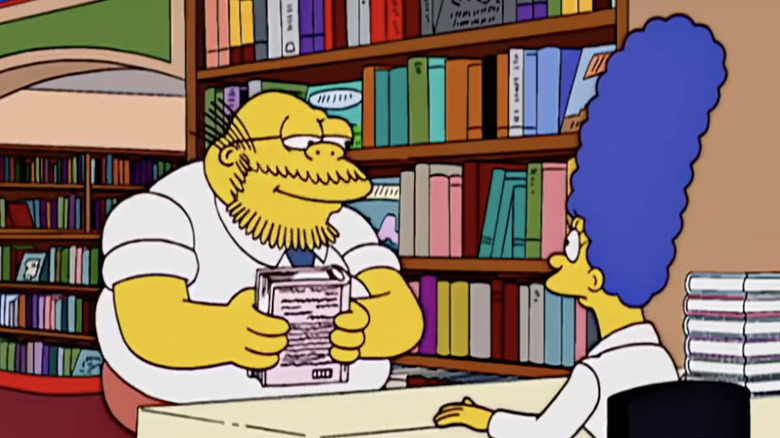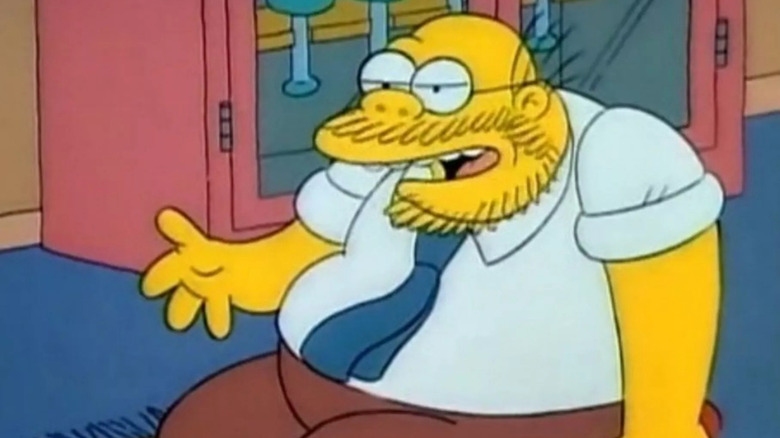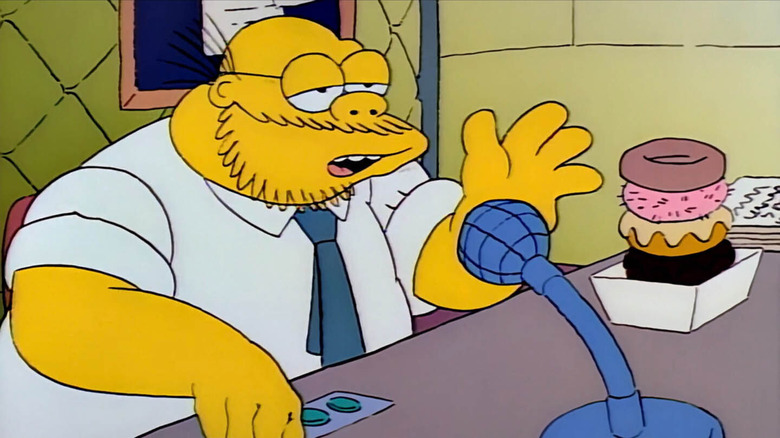Whatever Happened To Dr. Marvin Monroe, The Simpsons' Most 'Cursed' Character
The character of Dr. Marvin Monroe (Harry Shearer) first appeared in the "The Simpsons" episode "There's No Disgrace Like Home" (January 28, 1990). He would show up during the show's early seasons when Homer (Dan Castellaneta) was preoccupied with his family's perceived normal-ness. Homer looked at his home and saw the suburban ideals of a nuclear family slowly exploding. To combat this, Homer pawned the family TV — an object he saw as problematic anyway — and bought therapy sessions with Dr. Marvin Monroe, a family psychiatrist who promised "family bliss or double your money back." It seems the Simpsons were so dysfunctional that even Dr. Monroe couldn't cure them (a shock therapy session goes horribly awry).
Dr. Monroe typically appeared whenever "The Simpsons" required the word of a psychiatric specialist to aid in plot points. He was one of the show's many regular supporting characters, relegated to the background. However, the character died before he was given a chance to enact a plotline of his own. Dr. Monroe was modeled vaguely after Dr. David Viscott, a real-life shrink who starred in a late-late-night call-in helpline TV show in the '80s and '90s, as well as David Allen Monroe (best known for his books on out-of-body experiences).
Dr. Monroe eventually vanished from "The Simpsons," purportedly because actor Shearer ran his throat ragged doing the voice. In the continuity of the series, Dr. Monroe died. Audiences were told he was dead and we saw his tombstone. Weirdly, Dr. Monroe eventually returned to the show after seven years.
In the "Simpsons" making-of book "Springfield Confidential" by Mike Reiss and Mathew Klickstein, the showrunners recalled making "There's No Disgrace Like Home" and the arc of Dr. Marvin Monroe. It seems many of the show's writers felt the character was cursed.
The Curse of Dr. Monroe
Reiss recalled the very first table reading of "There's No Disgrace Like Home," a rehearsal that gathered the show's main cast members in one place for the first time. Reiss didn't even realize at the time that Bart and Lisa Simpson were voiced by adult women Nancy Cartwright and Yeardley Smith, and "Simpsons" regular Hank Azaria hadn't even been hired yet. When he was, he went back and re-recorded the stand-in dialogue that had been provided by comedian Christopher Collins. About Dr. Monroe, Reiss wrote:
"A local radio personality played psychiatrist Dr. Marvin Monroe, but he was fired at the end of the reading. (We later killed off the character of Marvin Monroe. And the real radio shrink we based him on committed suicide. All in all, kind of a cursed character.)"
Reiss wouldn't divulge which "radio personality" was fired, sadly. Shearer stepped in.
Reiss had the details of Dr. David Viscott incorrect. While he died young at the age of 58, it was not by his own hand. It seems that Dr. Viscott had separated from his wife and was living alone, suffering from a heart condition, complicated by diabetes. He died of heart failure.
Dr. Monroe, meanwhile, was killed off unceremoniously, his death only mentioned via context clues. In "Who Shot Mr. Burns (Part 2)" (September 17, 1995), one of Springfield's cops mentions Dr. Marvin Monroe Memorial Hospital. That was the first clue "Simpsons" viewers received about the character's fate. Dr. Monroe's death was confirmed in a trivia segment in "The Simpsons 138th Episode Spectacular" (December 3, 1995) when a narrator asked viewers to name two popular "Simpsons" characters who had died in the last year.
The answer? "If you said 'Bleeding Gums Murphy and Dr. Marvin Monroe,' you were wrong. They were never popular."
Dr. Monroe, trapped in limbo
The evidence would continue. Years later in "Alone Again, Natura-Diddly" (February 13, 2000) several characters walked past Dr. Monroe's tombstone. It was in the shape of a therapy couch.
But Dr. Monroe's mortality was brought into question when he reappeared for the episode "Diatribe of a Mad Housewife." In that episode, Marge (Julie Kavner) had authored a book and Dr. Monroe, suddenly alive again, arrived at a book signing to get Marge's autograph. Marge noted that she hadn't seen him in a while. "I've been very sick," he replied.
It's also possible that Monroe is dead and that his soul is merely trapped in limbo. Stranger things have happened on "The Simpsons." In "Treehouse of Horror XXV" (October 19, 2014), Dr. Monroe appeared as a ghost prevented from crossing over. Perhaps in "Diatribe," Marge met a ghostly version of Dr. Monroe. All told, Dr. Monroe appeared in 21 episodes of "The Simpsons," not counting mere background photos or re-used archive footage ("The Simpsons" has indeed featured several clip shows).
Dr. Monroe was clearly meant as a parody of pop psychology, serving as a reminder that mental health, like everything else, has been grossly commodified. His guarantee of "Family bliss or double your money back" satirized the over-commercialization of all things, rampant throughout the 1980s. Once the 1980s had ended, however, and more sensitive language was adopted by the public at large (it was called "politically correct" at the time), Dr. Monroe's function came to an end. Whether or not he remains dead, in limbo, or has come back to life remains to be seen.


